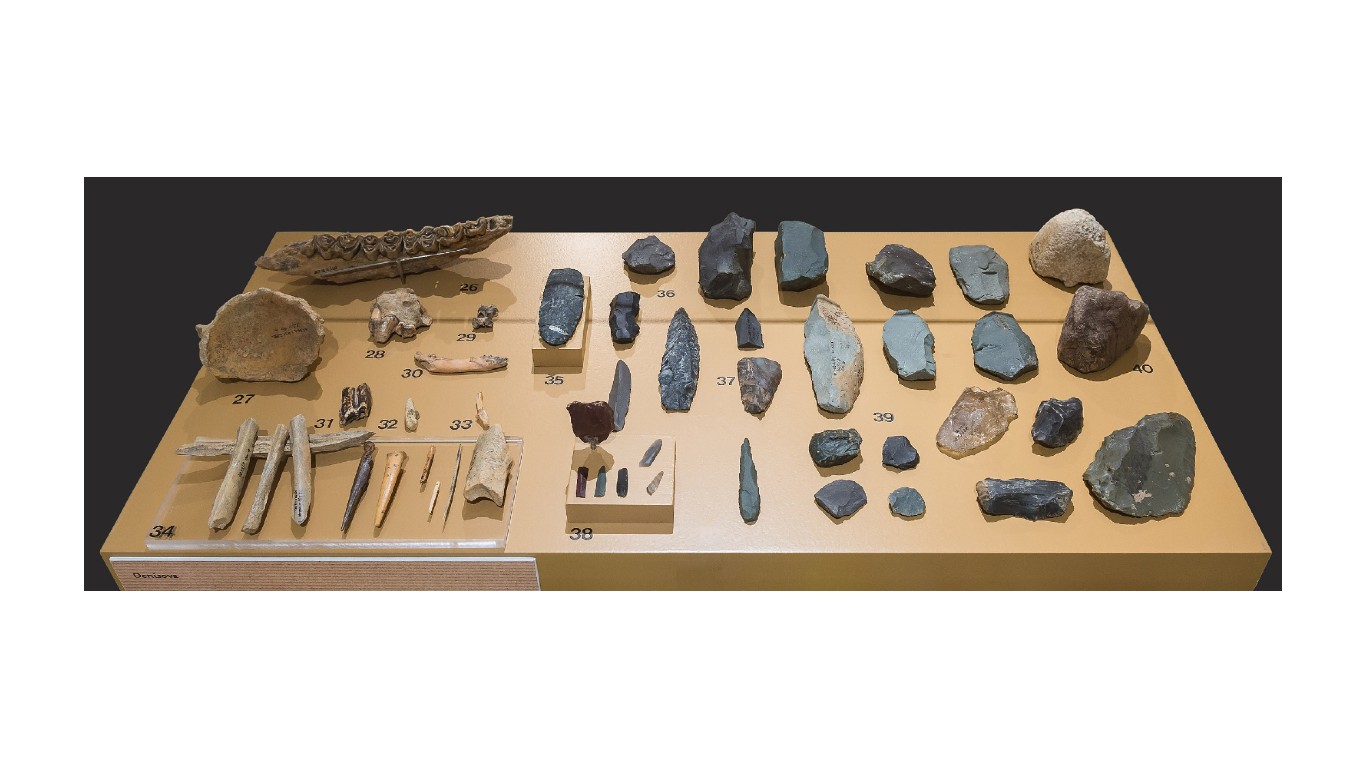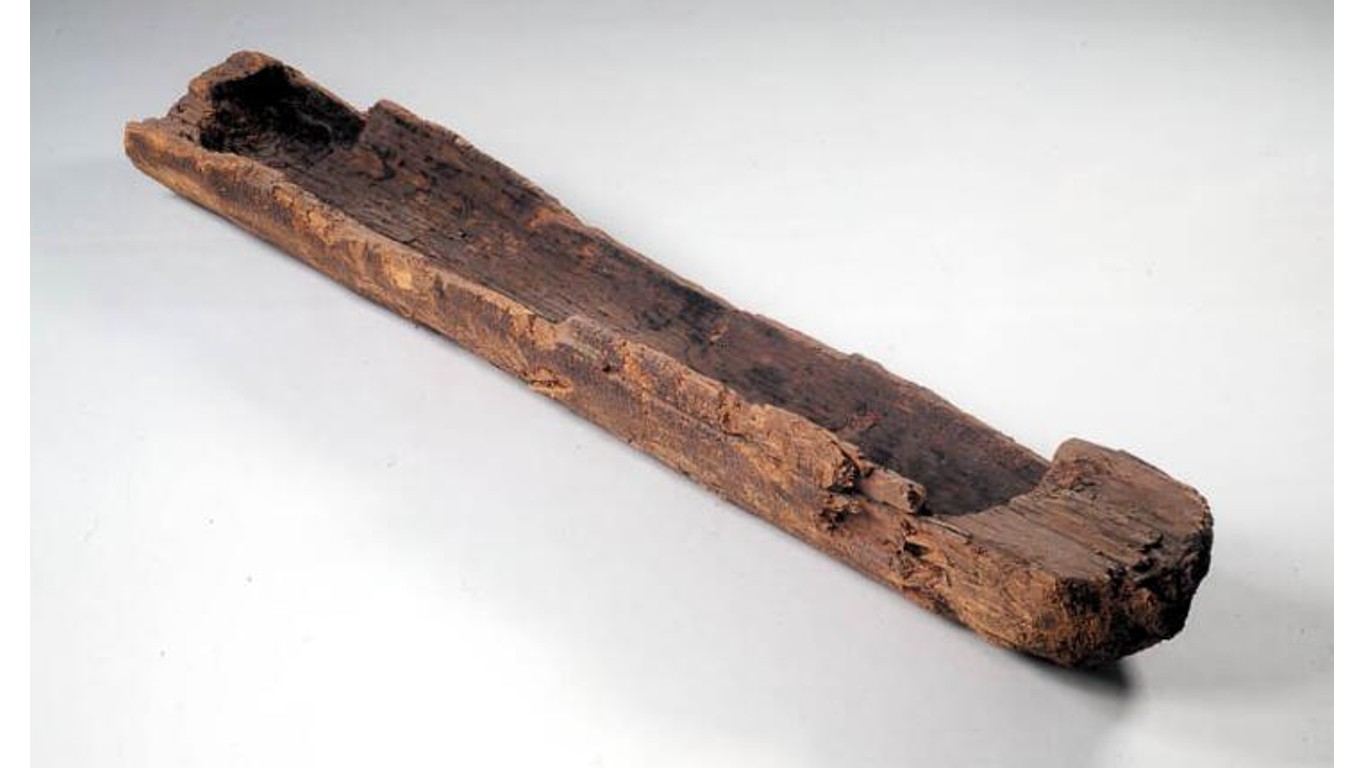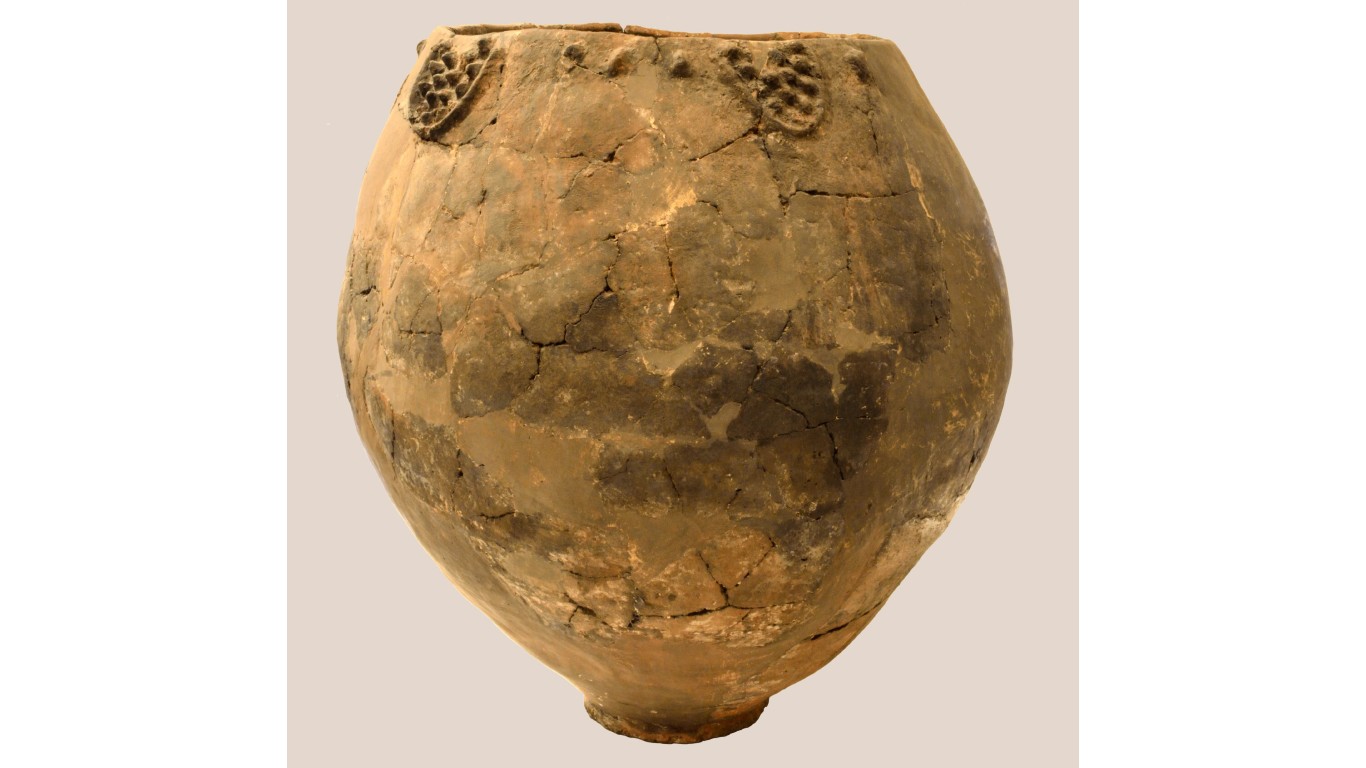
The earliest wheels were apparently made some 5,500 years ago in Mesopotamia -but they weren’t the wheels we think of today. Rather, they were potter’s wheels. It wasn’t until they’d been around for another 300 years that wheels were attached to wagons and chariots.
For all the credit the wheel gets for being the first “modern” invention that changed the world, other innovations came well before the disks that allowed our forefathers to travel and transport goods. In fact, archeologists have uncovered a number of inventions pre-dating the wheel, indicating that our clever forebears have been creating for many thousands of years. (Here are some ancient inventions you thought were modern.)
And each of these inventions has had a profound impact on human development. Walking is easier with shoes, and a glass of wine relaxes us after a long day at work. Both were invented many years before the wheel. And William Congreve’s often misquoted phrase that “Music has charms to soothe the savage breast” might well have made sense to the Neanderthals who – believe or not – invented the flute.
This is not to denigrate the wheel. Its importance to our daily lives is immeasurable. It’s just that humans were designing ingenious creations before the first wheel was rolled out. (These are the 25 oldest things in the world.)
Click here to see 14 inventions that predate the wheel
To compile a list of human inventions that predate the wheel, 24/7 Tempo reviewed historical publications on early innovations that occurred before the wheel’s invention in around 3500 B.C. from sources including Smithsonian Magazine and Britannica.
1. Cutting tools
> Earliest known examples: circa 3,000,000 B.C.
Homo habilis, an early human ancestor, invented cutting or stone tools. The process was simple: Take a stone, smash another stone against it to flake off chips leaving a sharpened edge and a tool that could be used for cutting. In a clever twist, later human ancestors attached the cutting tool to a shaft for easier handling.
[in-text-ad]
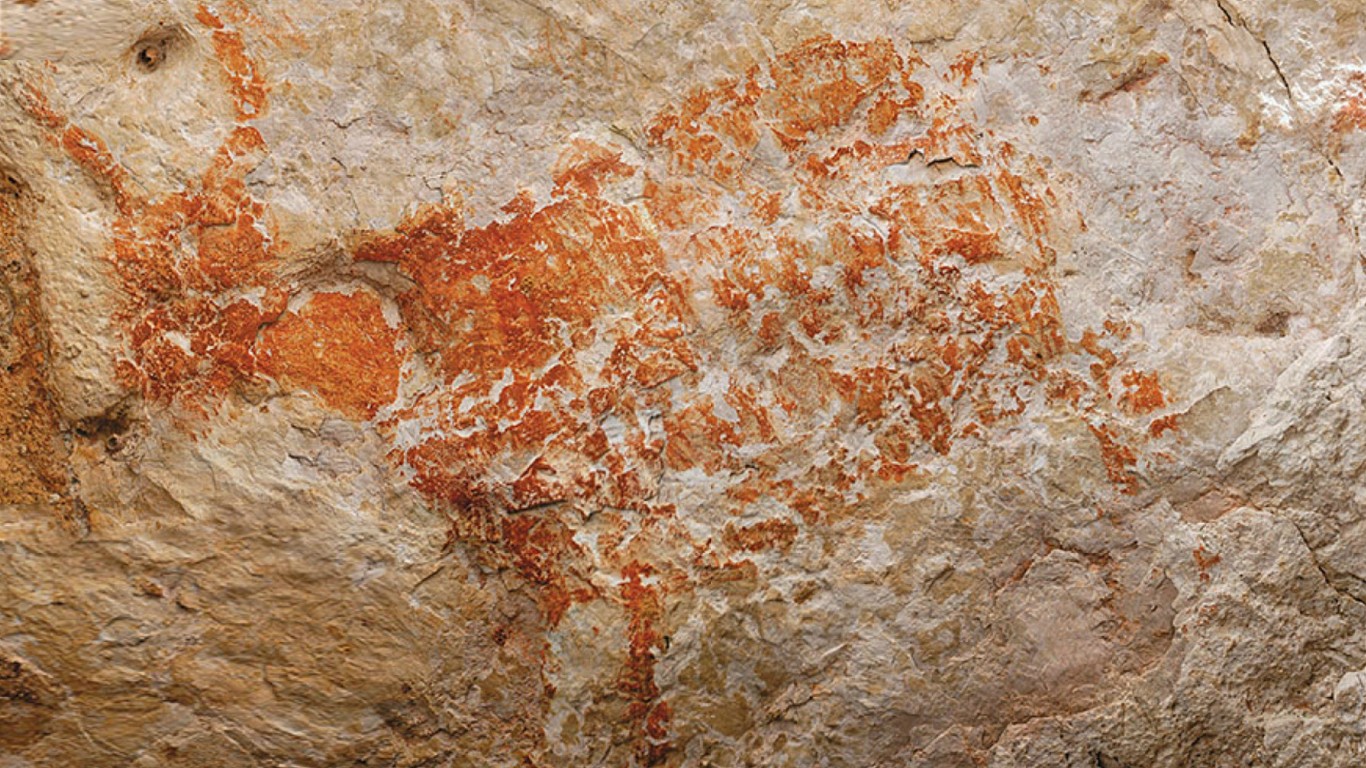
2. Art
> Earliest known examples: circa 100,000 B.C.
When we think of ancient art, we think of cave paintings like the ones dating back 40,000 years or more that were found in Europe. One of the discoveries included a depiction of three feral pigs in a cafe on the Indonesian island of Sulawesi that has been dated at 45,500 years of age. But shells that might have been used as paint pots and the remains of red ochre and yellow dyes dating back to around 100,000 B.C. have been found in a cave in South Africa, hinting at our ancestors’ earliest attempts at art.

3. Bow and arrow
> Earliest known examples: circa 72,000-60,000 B.C.
The first examples of the bow and arrow have been found in South Africa and Sri Lanka. The earliest European examples are much more recent, found in Germany and dated to around 16,000 B.C, The invention played an important role in human development. With a bow and arrow, our ancestors could kill game (or human enemies) from a distance, not risking death from an up-close encounter.
4. Flute
> Earliest known examples: circa 60,000 B.C.
Maybe the Neanderthals weren’t as backward or, well, as Neanderthal as we assume. Apparently, they loved music and invented the earliest flutes around 60,000 B.C. The first one discovered comes from a cave in what is now Slovenia, and was fashioned from the thigh bone of a young cave bear and punctured with four holes.
[in-text-ad-2]

5. Rope
> Earliest known examples: circa 50,000 B.C.
Not only did Neanderthals invent the flute, they also crafted ropes, weaving fibers from the bark of conifer trees into one long string, which could be used to make nets, bags, or clothing. The first rope was found in a cave in France and is said to be 50,000 years old. A tool for making rope, dating from around 40,000 B.C., was found several years ago in Germany.
6. Sewing needles
> Earliest known examples: circa 50,000 B.C.
Discovered in a cave in Siberia, the first sewing needle was made of bird bone with an opening for thread at the top. About three inches long, it could still be used today for sewing. Archaeologists believe the sewing needle was crafted by an extinct subspecies of humans known as the Denisovans.
[in-text-ad]

7. Agriculture
> Earliest known examples: circa 21,000-3000 B.C.
It can be argued that agriculture is more of a development than an invention, but whatever it is, agriculture – the cultivation of plants and raising of livestock – freed humans from the nomadic lifestyle required for hunting and gathering and allowed the development of settlements and then towns and cities. Archaeologists have identified 11 separate regions of the world in which agriculture developed, and it grew in increments over many millennia, with the oldest examples dating back 23,000 years in the Middle East. Among the earliest known crops included emmer wheat, oats, barley, peas, lentils, chickpeas, and flax. The first farm animals to be domesticated were sheep, around 11,000 B.C. in Mesopotamia.
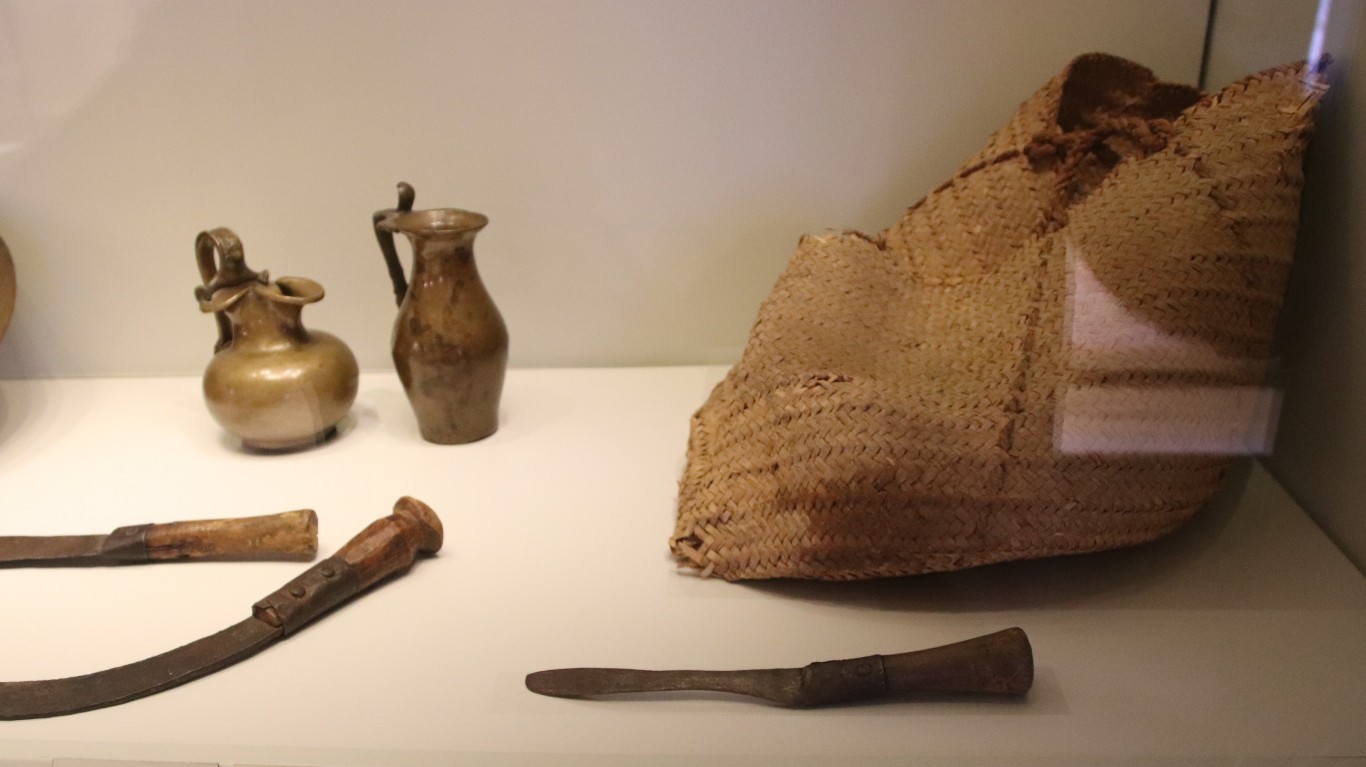
8. Baskets
> Earliest known examples: 8500 B.C.
The oldest basket known to us was discovered in 2021 in the Judean desert in modern-day Israel. It was made about 10,500 years ago during the Pre-Pottery Neolithic period. Archeologists aren’t sure what it was made of, but it had a lid and could hold about 92 liters (24 gallons or 203 pounds) of something. Those who discovered it were able to discern that it was crafted by two people, one of whom was left-handed.
9. Boats
> Earliest known examples: circa 8000 B.C.
Before we conquered the air with planes, we floated over the water with boats. The earliest evidence of boats, called Pesse canoes (after the Dutch village near where the oldest example was found), were simply hollowed out tree trunks. But they got the job done.
[in-text-ad-2]
10. Shoes
> Earliest known examples: circa 8000 B.C.
Walking across pavement would be pretty uncomfortable without shoes. But think about what our ancient ancestors had to contend with – sharp rocks and pestering animals, among other things. The shoe solved all that. It may have been an American invention: The earliest examples found thus far are sandals made from bark, discovered in a cave in Oregon. The earliest leather shoe, dating from around 3500 B.C., were found in Armenia. The first example of a shoe were found in caves in America, China, and Armenia. There’s a possibility, however, that the Chinese were wearing shoes of some sort as early as 40,000 B.C. – a supposition archaeologists base on changes in the shape of feet and toes that indicate the wearing of foot coverings.
11. Bricks
> Earliest known examples: circa 7500 B.C.
We take bricks for granted, but without these humble inventions, we couldn’t build roads or our homes. The forebears of modern bricks were made of dried earth, either of earthen clay or mud left to dry in the sun. The oldest surviving bricks, dating back more than 9,000 years, were discovered in what are now Syria and Turkey.
[in-text-ad]
12. Wine
> Earliest known examples: circa 7000/6000 B.C.
If you’re sipping a glass of wine now, you can thank ancient vintners in places as diverse as Georgia and China. At the Jiahu archeological site in China’s Henan Province, archaeologists discovered a ceramic jar about 9,000 years old that had been filled with rice, honey, and fruit to make a sweet alcoholic concoction. It is uncertain whether grapes were used, but the earliest undisputed evidence of grape wine, dating back about 8,000 years, is residue found in jars near the Georgian capital of Tbilisi

13. Textiles
> Earliest known examples: circa 6000 B.C.
Organic (and in modern times, also inorganic) fibers woven into textiles, we’re able to make clothing, coverings, baskets, and other useful items. But pinpointing the origins of woven cloth is difficult. Organic fibers degrade quickly and thus are hard to find in archeological digs. While some archaeologists have used evidence of objects used in the weaving process to posit much earlier dates, and while flax fibers of the kind used for textiles have been dated back to around 32,000 B.C., the earliest actual woven fabric discovered thus far are funeral wrappings found in Anatolia, in what is now Turkey, carbon-dated to 6000 B.C.

14. Glass
> Earliest known examples: 4000 B.C.
Glass occurs organically in nature. Obsidian glass, in particular, forms when lava from a volcano eruption quickly cools and hardens into a rock. This naturally occurring glass was used during the Stone Age. But man-made glass was first observed 6,000 years ago in Syria, ancient Egypt, Lebanon, and Mesopotamia. Man-made glass was first made into jewelry (most often as beads), knives, and arrowheads. Glass was even used as currency in ancient times.
Are You Ahead, or Behind on Retirement? (sponsor)
If you’re one of the over 4 Million Americans set to retire this year, you may want to pay attention.
Finding a financial advisor who puts your interest first can be the difference between a rich retirement and barely getting by, and today it’s easier than ever. SmartAsset’s free tool matches you with up to three fiduciary financial advisors that serve your area in minutes. Each advisor has been carefully vetted, and must act in your best interests. Start your search now.
Don’t waste another minute; get started right here and help your retirement dreams become a retirement reality.
Thank you for reading! Have some feedback for us?
Contact the 24/7 Wall St. editorial team.

 24/7 Wall St.
24/7 Wall St.
